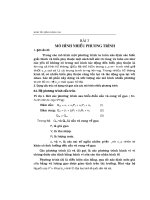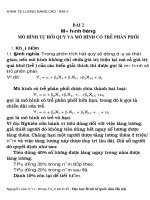- Trang chủ >>
- Đại cương >>
- Kinh tế vĩ mô
Bài 10: Mô hình Count Data
Bạn đang xem bản rút gọn của tài liệu. Xem và tải ngay bản đầy đủ của tài liệu tại đây (604.07 KB, 28 trang )
<span class='text_page_counter'>(1)</span><div class='page_container' data-page=1>
COUNT DATA MODELS
</div>
<span class='text_page_counter'>(2)</span><div class='page_container' data-page=2>
Count data and Poisson distribution
Poisson model
Negative Binomial model
Application of count models
</div>
<span class='text_page_counter'>(3)</span><div class='page_container' data-page=3>
Count data and Poisson distribution
Sometimes the dep var is a non-negative integer
Example:
takeover bids received by a target firm
number of unpaid credit installment
number of accidents
number of prepaid mortgage loans
<b>These are the number of incidence happened in a </b>
<b>given period of time</b>
0,1, 2,...,
</div>
<span class='text_page_counter'>(4)</span><div class='page_container' data-page=4>
Count data and Poisson distribution
For dependent variable that is an non-negative
integer
it is an integer
</div>
<span class='text_page_counter'>(5)</span><div class='page_container' data-page=5>
Count data and Poisson distribution
Poisson distribution describe the probability of
events occurring k times in a given period of time
The probability function is
</div>
<span class='text_page_counter'>(6)</span><div class='page_container' data-page=6></div>
<span class='text_page_counter'>(7)</span><div class='page_container' data-page=7></div>
<span class='text_page_counter'>(8)</span><div class='page_container' data-page=8></div>
<span class='text_page_counter'>(9)</span><div class='page_container' data-page=9></div>
<span class='text_page_counter'>(10)</span><div class='page_container' data-page=10>
Properties of Poisson distribution
One parameter
Mean is equal to variance
Thus, variance increases with mean
If we model lambda as a function of explanatory
variable, we have the Poisson model
var
</div>
<span class='text_page_counter'>(11)</span><div class='page_container' data-page=11>
Poisson model
Mean
Probability
Log-likelihood function
Estimation method: Maximum Likelihood
|
<i>X</i>
<i>i</i><i>i</i>
<i>E y X</i>
<i>e</i>
Pr
!
!
<i>Xi</i>
<i>i</i>
<i>k</i>
<i>X</i>
<i>e</i>
<i>k</i>
<i>e</i>
<i>e</i>
<i>e</i>
<i>y</i>
<i>k</i>
<i>k</i>
<i>k</i>
<sub></sub>
<sub></sub>
1
log
<i>i</i>log
!
<i>N</i>
<i>X</i>
<i>i</i>
<i>i</i>
<i>i</i>
<i>i</i>
<i>L</i>
<i>e</i>
<i>y X</i>
<i>y</i>
</div>
<span class='text_page_counter'>(12)</span><div class='page_container' data-page=12>
Interpreting Poisson model estimates
We are interested in: when X changes, how the
expected value of y changes
The marginal effect
|
<i>X</i>
<i>i</i><i>i</i>
<i>E y</i>
<i>X</i>
<i>e</i>
|
<i>i</i>
<i>i</i>
<i>X</i>
<i>i</i>
<i>E y</i>
<i>X</i>
<i>e</i>
<i>X</i>
<sub></sub>
</div>
<span class='text_page_counter'>(13)</span><div class='page_container' data-page=13>
Issue in Poisson model
Under Poisson distribution, mean = variance
This means variance increases with mean
If not
variance increase at a
LOWER
rate than mean:
UNDERDISPERSION
variance increase at a
HIGHER
rate than mean:
</div>
<span class='text_page_counter'>(14)</span><div class='page_container' data-page=14>
Negative Binomial Model
If we model
Then the mean is
And the variance
<b>This is negative binomial model</b>
Note if then the model collapse to Poisson.
Pr
!
<i>k</i>
<i>e</i>
<i>y</i>
<i>k</i>
<i>k</i>
<sub></sub>
|
<i>X</i>
<i>i</i><i>i</i>
<i>E y</i>
<i>X</i>
<i>e</i>
2
var
<i>y X</i>
<i><sub>i</sub></i>
|
0
</div>
<span class='text_page_counter'>(15)</span><div class='page_container' data-page=15>
Analyze the number of non-payments during a
credit contract
</div>
<span class='text_page_counter'>(16)</span><div class='page_container' data-page=16>
Data
Dependent variable: number of nonpayment
during a credit contract
Independent variables
duration: contracting period (month)
age: (year)
collateral: dummy, 1 = with collateral
edu: schooling years (years)
banking: dummy, 1 = receiving salary via bank account
salary: monthly income (mil. VND)
</div>
<span class='text_page_counter'>(17)</span><div class='page_container' data-page=17>
The number of nonpayments
Total 2,110 100.00
</div>
<span class='text_page_counter'>(18)</span><div class='page_container' data-page=18>
Poisson model in Stata
_cons 2.074566 .1463598 14.17 0.000 1.787706 2.361426
married .459314 .033624 13.66 0.000 .3934121 .5252159
salary .0014747 .0045834 0.32 0.748 -.0075086 .0104581
banking -4.108164 .1516297 -27.09 0.000 -4.405353 -3.810975
edu -.0899637 .0048852 -18.42 0.000 -.0995387 -.0803888
collateral -1.540261 .0434424 -35.46 0.000 -1.625407 -1.455116
age -.035701 .0028549 -12.51 0.000 -.0412964 -.0301056
duration .0599389 .0031207 19.21 0.000 .0538225 .0660554
nonpay Coef. Std. Err. z P>|z| [95% Conf. Interval]
Log likelihood = -1985.4326 Pseudo R2 = 0.6086
Prob > chi2 = 0.0000
LR chi2(7) = 6173.59
Poisson regression Number of obs = 2110
Iteration 3: log likelihood = -1985.4326
Iteration 2: log likelihood = -1985.4327
Iteration 1: log likelihood = -1985.7743
Iteration 0: log likelihood = -2066.391
</div>
<span class='text_page_counter'>(19)</span><div class='page_container' data-page=19>
Hypothesis testing
H0: coef of all demographic variables equal zero
Prob > chi2 = 0.0000
chi2( 3) = 697.41
( 3) [nonpay]married = 0
</div>
<span class='text_page_counter'>(20)</span><div class='page_container' data-page=20>
Prediction
npay 2110 1.891943 2.583285 .0035831 21.4108
Variable Obs Mean Std. Dev. Min Max
. sum npay
</div>
<span class='text_page_counter'>(21)</span><div class='page_container' data-page=21>
Marginal effects
(*) dy/dx is for discrete change of dummy variable from 0 to 1
married* .1951712 .01804 10.82 0.000 .15982 .230522 .555924
salary .0006373 .00198 0.32 0.748 -.003245 .00452 11.9332
banking* -2.093989 .04643 -45.10 0.000 -2.185 -2.00298 .388152
edu -.0388793 .00305 -12.75 0.000 -.044856 -.032902 11.9995
collat~l* -.6827921 .04277 -15.96 0.000 -.766627 -.598957 .453555
age -.0154288 .00151 -10.19 0.000 -.018397 -.01246 34.9464
duration .0259036 .002 12.93 0.000 .021976 .029832 23.9223
variable dy/dx Std. Err. z P>|z| [ 95% C.I. ] X
= .43216618
y = predicted number of events (predict)
Marginal effects after poisson
</div>
<span class='text_page_counter'>(22)</span><div class='page_container' data-page=22>
Marginal effects at a value point
(*) dy/dx is for discrete change of dummy variable from 0 to 1
married* .0236672 .00443 5.34 0.000 .014985 .03235 1
salary .0000948 .0003 0.31 0.754 -.000498 .000688 30
banking* -3.845207 .33501 -11.48 0.000 -4.50182 -3.18859 1
edu -.0057814 .00102 -5.68 0.000 -.007777 -.003786 16
collat~l* -.0504903 .00878 -5.75 0.000 -.067693 -.033288 0
age -.0022943 .00044 -5.21 0.000 -.003158 -.001431 34
duration .0038519 .00069 5.59 0.000 .002501 .005203 24
variable dy/dx Std. Err. z P>|z| [ 95% C.I. ] X
= .0642636
y = predicted number of events (predict)
Marginal effects after poisson
</div>
<span class='text_page_counter'>(23)</span><div class='page_container' data-page=23>
Marginal effects at a value point
(*) dy/dx is for discrete change of dummy variable from 0 to 1
married* .1960826 .01812 10.82 0.000 .160569 .231597 .555924
salary .0006403 .00199 0.32 0.748 -.00326 .004541 11.9332
banking* -2.103768 .04655 -45.19 0.000 -2.19501 -2.01252 .388152
edu -.0390608 .00306 -12.75 0.000 -.045065 -.033057 11.9995
collat~l* -.6859805 .04296 -15.97 0.000 -.770188 -.601773 .453555
age -.0155008 .00152 -10.19 0.000 -.018483 -.012519 34.9464
duration .0260245 .00202 12.90 0.000 .022071 .029978 24
variable dy/dx Std. Err. z P>|z| [ 95% C.I. ] X
= .43418424
y = predicted number of events (predict)
Marginal effects after poisson
means used for age collateral edu banking salary married
</div>
<span class='text_page_counter'>(24)</span><div class='page_container' data-page=24>
Negative binomial model
Likelihood-ratio test of alpha=0: chibar2(01) = 3.5e-05 Prob>=chibar2 = 0.498
alpha 1.21e-08 1.89e-06 5.9e-141 2.5e+124
/lnalpha -18.2266 155.4434 -322.8902 286.4369
_cons 2.074564 .1463599 14.17 0.000 1.787704 2.361424
married .4592988 .033624 13.66 0.000 .393397 .5252006
salary .0014748 .0045834 0.32 0.748 -.0075086 .0104581
banking -4.108135 .1516278 -27.09 0.000 -4.40532 -3.81095
edu -.0899611 .0048852 -18.41 0.000 -.099536 -.0803861
collateral -1.540237 .0434421 -35.45 0.000 -1.625382 -1.455092
age -.0356999 .0028549 -12.50 0.000 -.0412953 -.0301044
duration .0599365 .0031207 19.21 0.000 .05382 .0660529
nonpay Coef. Std. Err. z P>|z| [95% Conf. Interval]
Log likelihood = -1985.4326 Pseudo R2 = 0.4782
Dispersion = mean Prob > chi2 = 0.0000
LR chi2(7) = 3639.28
Negative binomial regression Number of obs = 2110
</div>
<span class='text_page_counter'>(25)</span><div class='page_container' data-page=25>
Application of Count Models
Dione&Vanasse (1992) Automobile Insurance
Ratemaking in the Presence of Asymmetrical
<i>Information. J of Applied Econometrics 7: 149-65.</i>
Quebec drivers 1982-83, for insurers to classify
drivers.
dep var: number of accidents reported by police
indep var: driver’s characteristics [age, gender,
</div>
<span class='text_page_counter'>(26)</span><div class='page_container' data-page=26>
Application of Count Models
Greene (1994) Accounting for Excess Zeros and Sample
Selection in Poisson and Negative Binomial Regression
<i>Models. Working Paper, New York University.</i>
data of credit card applicants
dep var: number of derogatory reports
indep var:
income, expenditure
age
</div>
<span class='text_page_counter'>(27)</span><div class='page_container' data-page=27>
Application of Count Models
Dione et al. (1996) Count Data Models for a Credit
<i>Scoring System. J of Empirical Finance 3: 303-25.</i>
data of 4,700 clients granted credit by a bank
dep var: number of unpaid monthly payments during
the contracting period
indep var:
income
age
duration of contracting period
marital status
</div>
<span class='text_page_counter'>(28)</span><div class='page_container' data-page=28>
Application of Count Models
Jaggia&Thosar (1993) Multiple Bids as a Consequence of Target
<i>Management Resistance : A Count Data Approach. Review of </i>
<i>Qualitative Finance and Accounting 3: 447-57.</i>
data of 126 firms that were targets of tender offers 1978-85
dep var: number of bids after the initial bid received
indep var:
legal defense
real restructuring
financial restructuring
white knight
initial bid premium
institutional holdings
size
</div>
<!--links-->









